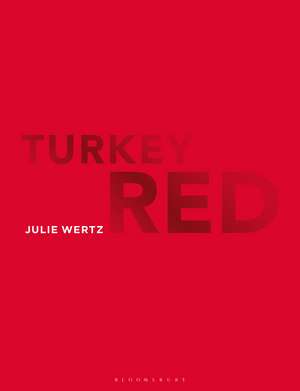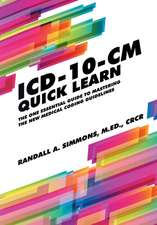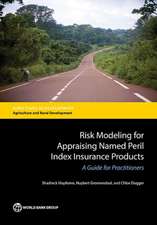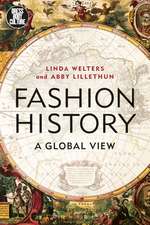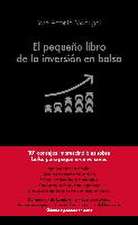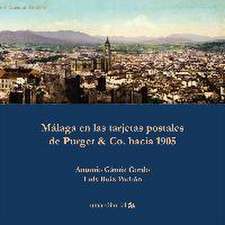Turkey Red: Textiles that Changed the World
Autor Julie Wertzen Limba Engleză Paperback – 21 feb 2024
| Toate formatele și edițiile | Preț | Express |
|---|---|---|
| Paperback (1) | 180.88 lei 3-5 săpt. | |
| Bloomsbury Publishing – 21 feb 2024 | 180.88 lei 3-5 săpt. | |
| Hardback (1) | 503.80 lei 3-5 săpt. | |
| Bloomsbury Publishing – 21 feb 2024 | 503.80 lei 3-5 săpt. |
Preț: 180.88 lei
Preț vechi: 194.36 lei
-7% Nou
Puncte Express: 271
Preț estimativ în valută:
34.61€ • 36.14$ • 28.65£
34.61€ • 36.14$ • 28.65£
Carte disponibilă
Livrare economică 15-29 martie
Preluare comenzi: 021 569.72.76
Specificații
ISBN-13: 9781350216501
ISBN-10: 135021650X
Pagini: 232
Ilustrații: 92 color illus
Dimensiuni: 189 x 246 x 25 mm
Greutate: 0.45 kg
Editura: Bloomsbury Publishing
Colecția Bloomsbury Visual Arts
Seria Textiles that Changed the World
Locul publicării:London, United Kingdom
ISBN-10: 135021650X
Pagini: 232
Ilustrații: 92 color illus
Dimensiuni: 189 x 246 x 25 mm
Greutate: 0.45 kg
Editura: Bloomsbury Publishing
Colecția Bloomsbury Visual Arts
Seria Textiles that Changed the World
Locul publicării:London, United Kingdom
Caracteristici
Presents a historical example of the global textile industry in an era when the global impact of textile consumption was an increasingly pressing concern
Notă biografică
Julie Wertz is Beal Family Postgraduate Fellow in Conservation Science at Harvard Art Museums, USA.
Cuprins
List of FiguresPrefaceAcknowledgmentsNote on the textIntroduction1. The Most Brilliant Color Dyed on Cotton1.1. Defining Turkey red1.1.1. A reputable red1.1.2. A complicated process1.2. Identifying Turkey red1.3. Material record1.4. Conclusion2. Global Exchanges and Anthraquinone Dyes2.1. The origin and dissemination of Turkey red2.1.1. India2.1.2. Indonesia2.1.3. The Levant and the Ottoman Empire2.1.4. The Hapsburg Empire2.1.5. France2.1.6. Britain2.2. Madder2.2.1. The cultivation of madder2.2.2. Madder composition and derivatives2.3. Synthetic alizarin2.3.1. Understanding alizarin2.3.2. Alizarin synthesis and patent disputes2.3.3. Synthetic alizarin products2.4. Conclusion3. The Dyeing, Chemistry, and Technological Advances of Turkey Red3.1 Oiling3.1.1Oiling in the old process3.1.2The chemistry of oiled cotton3.1.3Ruminant dung and tannins3.1.4Turkey red oil and the new process3.1.5The Steiner process3.2 Aluminium3.2.1Precipitated aluminium soaps3.3 Dyeing3.3.1Color complexes in Turkey red3.3.2 Blood and albumen3.4. Clearing3.5. Conclusions4. Printed Turkey Red4.1. Textile printing methods 4.2. Discharge printing1.1.3.Lead plate press discharging1.1.4.Acid paste discharging4.3. A bright palette1.1.5.Black, blue, yellow, and green1.1.6.Identifying colorants on Turkey red prints4.4. Design1.1.7.Industrial design and production1.1.8.European design for the export market4.5. Conclusions5. Turkey Red in the Industrial Revolution5.1. Turkey red industry by country5.1.1.France5.1.2. England5.1.3. Scotland5.1.4. Switzerland5.1.5. The Netherlands5.1.6. North America5.1.7. Other locations5.2. Working conditions and labor5.3. Colonialism5.4. Conclusions6. Trade, Use, and Object Record6.1. Documentary evidence of availability6.2. How Turkey red was used6.2.1. Bandanas6.2.2. Domestic textiles, quilts and bedcovers6.2.3. Accessories, garments, and tools6.3.ConclusionsConclusionsGlossaryReferencesIndex
Recenzii
Wertz manages to wrangle the long history, broad geographies, scientific intricacies, and varied applications of Turkey red into a highly readable and easily understood text - a feat as awe-inspiring as the dyeing process that is the book's topic.
What a fantastic read! Mystery, time and magic have defined the process of creating bright red colours on cotton for centuries. Julie Wertz explains it very clearly in her beautifully illustrated book. A perfect read for both textile historians and modern-day enthusiasts of dyeing and colour.
What a fantastic read! Mystery, time and magic have defined the process of creating bright red colours on cotton for centuries. Julie Wertz explains it very clearly in her beautifully illustrated book. A perfect read for both textile historians and modern-day enthusiasts of dyeing and colour.
